When we last saw Kratos he had just defeated the Scylla, and had escaped a collapsing volcano. In the ensuing explosion he got hurtled over the city of Atlantis. If not for his godhood he would have died from the impact. He was thrown from the Methana Volcano to Crete. The skies changed completely. At the start of the game we were in a raging tempest. Now everything was black with ash, and dust blew across the ground. We could see the volcano in full eruption in the background. It was hurtling enormous chunks of flaming earth in all directions. We could hear the screams of the villagers as their city broke apart. It was one of the most amazing stages I had ever seen in the GoW series.
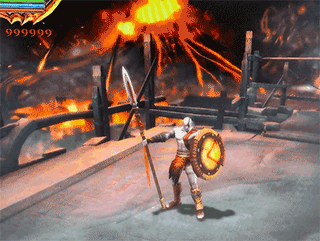
Kratos made his way across the apocalyptic landscape. Destruction was all around him. Walls, and temples collapsed in the distance, and we could see the Mediterranean Sea pouring into the fissures where Atlantis once stood. The god of war had to fight gorgons, harpies, and zombie-like Hoplite Soldiers under the burning debris. This portion of the game had so much going on that it took me several play throughs to catch all the details. In fact, it made me realize the level of depth that the series had always consisted of. From this point on rather than rush through each game I put on my Sony studio monitor headphones, and took my sweet time going through every corner of the levels trying to absorb as much as I could.
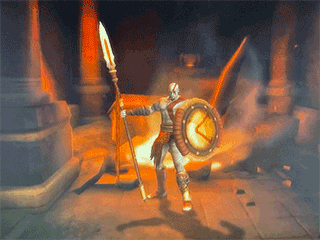
Slowing down the game play was something that modern developers had done in the GoW (2018), and GoW Ragnarok games, but was also the pacing changes seen in Uncharted, Tomb Raider, the Last of Us, Horizon Zero Dawn, and other AAA titles. The newer tempo forced audiences to slow down, and become invested in the world that Sony, and the other studios had created. It helped gamers, myself included, appreciate the level of depth that the developers had spent years working on. It was much easier to absorb the thousands of details created for the different realms. Sony Santa Monica accomplished this in GoW Ragnarok by having players spend 30+ hours traveling back, and forth between worlds, completing main, and side objectives. If modern games were built like the classic GoW titles then we would be able to rush through them in an afternoon, and completely miss years of work that went into creating them.
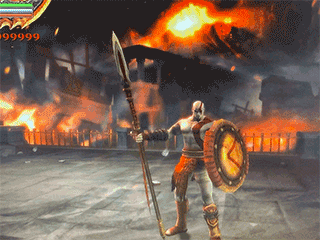
The developers at Ready at Dawn used the camera to frame the most important scenes in the game. It would close in during the combat scenes, then pan back while traversing so you could enjoy the spectacle happening all around. When they really wanted the gamer to feel like they were in the heart of the action they would completely surround Kratos in the smoke, explosions, and other effects generated by the game engine. One of my favorite shots in the game happens as Kratos is trying to get to the other side of Heraklion, the financial heart of Crete. I absolutely live for the 10 second rope slide in this game. Every game in the GoW series has a rope slide / chain slide scene. It’s a way to speed up travel from one area to another, but it can also be used to mask a new level loading. This time Kratos is sliding past blazing structures that are collapsing, but even a citizen that is on fire leaps out of a window, and into the inferno. This small detail lasts a half second, but is important enough to include. It is storytelling told through the action. No shot is wasted in the entire journey.
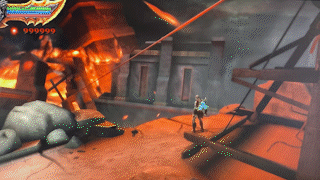
The Ghost of Sparta does a brilliant job of recreating the atmosphere from the various regions of the Mediterranean in a single adventure. We had already been in a tempest, and survived magma flows. There were ice, snow, and more weather events coming up. Can you name a portion of any modern GoW game that even had that type of diversity? Kratos defies Athena as she speaks to him from a statue in Crete. There is nothing she can say to get him to change his mind, and end his quest. He remembers that his brother was taken by two mysterious figures. We learn that they were Athena, and Ares in the darkness. Kratos makes it out of Crete, and begins climbing the hills. We’re some distance from the Volcano, but there are still fireballs hurtling through the sky. He reaches the Mounts of Aroania. The frozen cliffs where young Spartans would learn how to endure harsh elements, and survive against the wilderness.
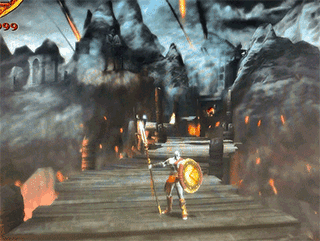
A shadowy demon is in the distance killing a lone Spartan. She is interrogating him, and trying to get the location of Kratos out of him. He does not relent, and she leaves him bleeding to death. Kratos catches up, and praises the dying man’s strength. He thanks the god of war before he passes away. Kratos makes his way through the mountain, and eventually reaches the demon. She is gutting another soldier. It is Erinys the daughter of Thanatos, the god of death. Erinys, and Kratos have a massive battle. She can summon golden magic, and even transform into a gigantic bird.
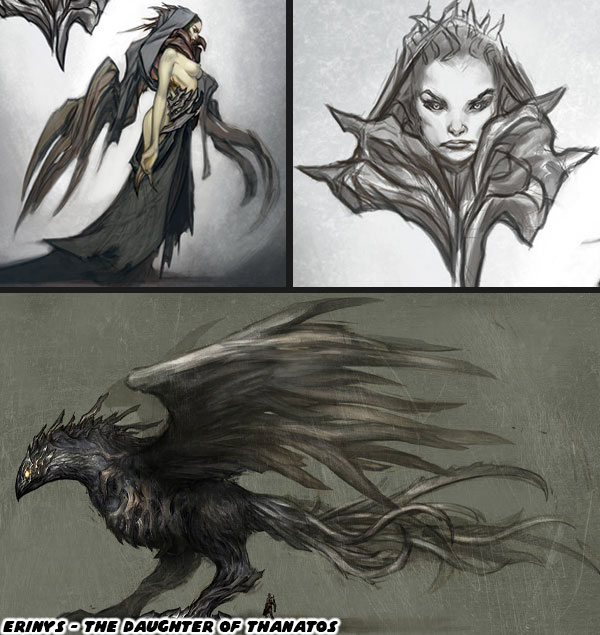
They have a tremendous battle where Kratos is dragged across the mountains until he gets the upper hand, and kills the goddess. The two crash in a rocky clearing. Kratos cuts off her arm, and steals her magic charm. It’s a small coil of an iron like material known as the Scourge of Erinys. It emits a golden spark that tracks down opponents, and steals their life force.
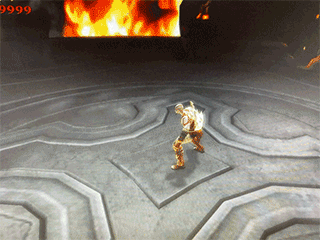
Kratos uses the magic to dispose of more demons trying to halt his progress. He walks a trail where we see other dead soldiers, overturned carts with arrows sticking out of them, and broken trees. Perhaps the work of raiders, or perhaps the remains of demon warriors that had just been there. As Kratos climbs the path we see the makings of an enormous wall, and a city behind. He has reached the gates of Sparta.
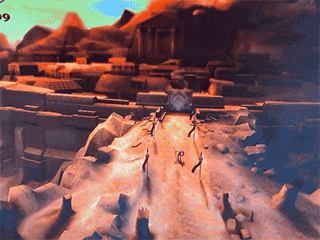
The game switches to a close, over the shoulder perspective, and the game play slows down tremendously. We cannot run, or fight, but instead walk through the streets. It is the type of slow, methodical pace of modern games, and it allows us to see his beloved home. His soldiers stand to attention, and the citizens hail the god of war. We see people shopping the fruit stands, enjoying a lively conversation, listening to musicians in front of a fountain. We hear the blacksmith sharpening his swords, and creating armor. A group of sex workers call out to the god, and beg him to join them. It would be the last time a sex mini game would be featured in the series. After handling his business Kratos continues. We see a Spartan teaching a collection of boys with shaved heads how to fight with a spear, and shield. Kratos keeps walking until he sees two boys practicing their spear combat in the streets. He is reminded of training with his younger brother. Deimos was born with a skin defect. A birthmark wraps across his head, back, torso, and arms. It was the tattoo pattern that Kratos would adopt after his brother was kidnapped. We can clearly see this detail in the cut scene. Kratos teaches his brother to be strong, even against bigger opponents. His final lesson was that a Spartan never lets his back hit the ground. His brother nods as he is helped back to his feet. Kratos snaps back to the present day.
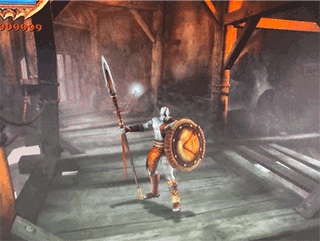
The path leading to the temple of Ares is hidden underground, through the Jails of Sparta. His men open the massive gate, and allow him to enter. Kratos descends into the prison where we go through the old, and echoing chambers. The level design is great, everything looks worn, and stylized. Heavy wooden doors with iron bolts anchoring them to the carved stone walls. Thick timbers shore up the walls. Coal embers provide light, and heat in the corners of the cell blocks. Metal gates, raised with thick chains separate the various cells. The air looks thick with dust. Every few moments we can see the dirt fall from the ceiling. This is where having headphones really comes in handy. Ready at Dawn put as much effort into the audio cues in the game, as they had with the visual details. This was especially evident as I was going through the jail. I could hear the murmuring of prisoners. The dripping of water. The cracking of torches, and the earth shifting, and falling. The chatter of monsters, hiding in the the recesses.
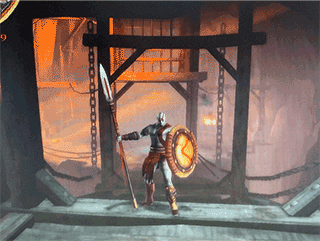
Kratos would pull a lever to move from one block of the jail to the other. In doing so a gate would go up allowing him entry. A timed release mechanism would pull the chains on other cells as well. Kratos would be acting as the executioner for the monsters that had been locked up. Every now, and then you would hear the roar of a lion. It sounded ferocious. Easily the most dangerous creature buried within the walls of the jail. I hoped that if would remain locked behind bars. There was a sound less intimidating echoing through the halls as well. In fact this sound was annoying. A whiny voice could be heard yelling. This guy would claim he was innocent. That he was only serving the true god of war. He challenged the audacity for the Spartans to lock him up, and demanded to be freed. This was our introduction to the Dissenter. When Kratos pulled the lever to allow him to enter the block his gate jammed, and dropped. However the timed locks inside the block still opened the cells. The fat-faced Dissenter praised Ares, and took off running. Kratos had to manually lift the gate, and continue through the prison. There was no sign of the disrespectful prisoner as I carried on. As I progressed through the jail I had no idea that my absolute favorite mid-boss fight in the entire history of the franchise was just around the corner.
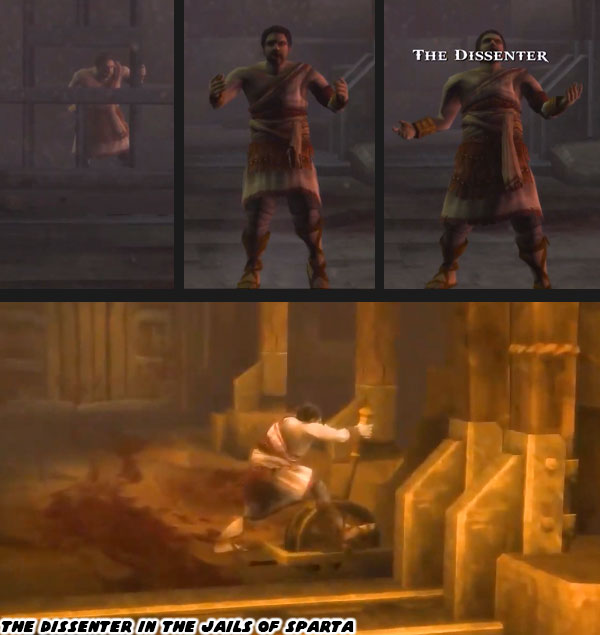
When we finally caught up to the Dissenter we could hear him struggling with a lever. He was calling out “Lord Ares give me strength!” I wish I had been paying a little more attention to the floor before I entered the room. There were a few splashes of blood in other parts of the jail, perhaps a bloody handprint from a former prisoner. However the floors, and walls in this block were smeared with blood. You could make out the streaks where something, or someone had been dragged across the floor. There were also enormous red paw prints, and claw marks carved into the cells. As Kratos enters the block the Dissenter is able to pull the lever, and drops the gates on him. Trapping him inside with an amazing mid-boss. A heavy wooden cell door, reinforced with iron bars lifts, and The Piraeus Lion leaps out. My jaw literally hit the floor when he appeared. I played through the entire encounter the first time with my mouth wide open.
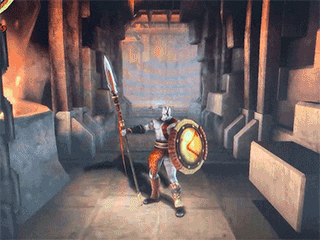
The creature was breathtaking in its design, and animation. It would stalk Kratos around the block, and cover its width with a single pounce. Its roar was so powerful that it could make you go dizzy for a moment. You could see its face was brilliantly animated as it growled, and snarled. It was hunting the god of war. This beast was far from any normal lion. He was absolutely massive, bigger than a horse, and almost as big as an elephant. On later play throughs I could tell that the model, and some of the animations were based on a creature called the Morpheus Beast from the Chains of Olympus. However this model was larger, and more aggressive. Earlier in the jail I had to fight a minotaur, which is normally a tough fight, but the Piraeus Lion dwarfed it in size, and strength. The lion was covered in scars, its hide, and mane had arrows, and swords sticking out of it. Who knows how many men had died trying to kill it, let alone capture it. This was some awesome storytelling using just the visual cues.
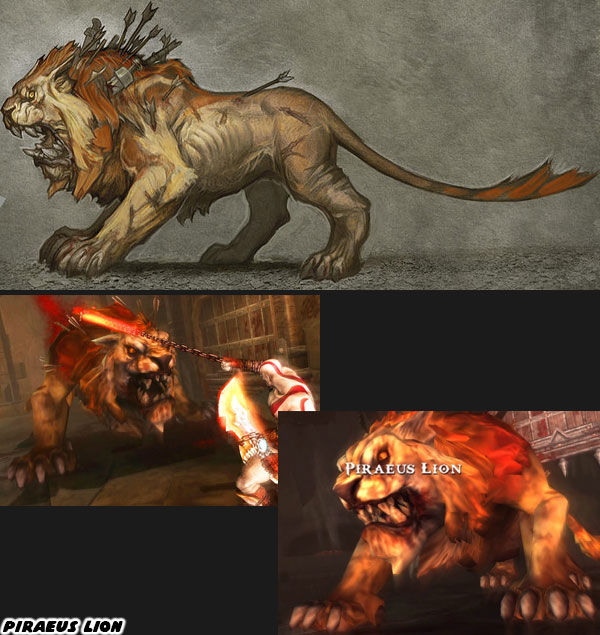
There were multiple reasons that I enjoyed this battle. Especially when compared to all of the other fights in the series. First, and foremost that this was the only time you fought the Piraeus Lion. He was a heavy hitter that would not be recycled in other locations, or wearing different skins like a cyclops, or minotaur. The other reason I enjoyed the fight was the stage itself. The entire Jails of Sparta portion was designed around the encounter. The audio cues, the roars, existed to intimidate us before we could even see him. The taunting Dissenter was bait to lead us into a trap. Although the series had featured monsters a thousand times larger it was the intimacy of the encounter that also mattered. We were not in the middle of Mediterranean Sea, or the shores of Attica. We were instead trapped inside a prison block, surrounded by stone, iron, and buried deep under the city of Sparta. This increased the tension much more than any other encounter I could think of. Lastly the reason I enjoyed this fight was the history, and mythology it was based on.
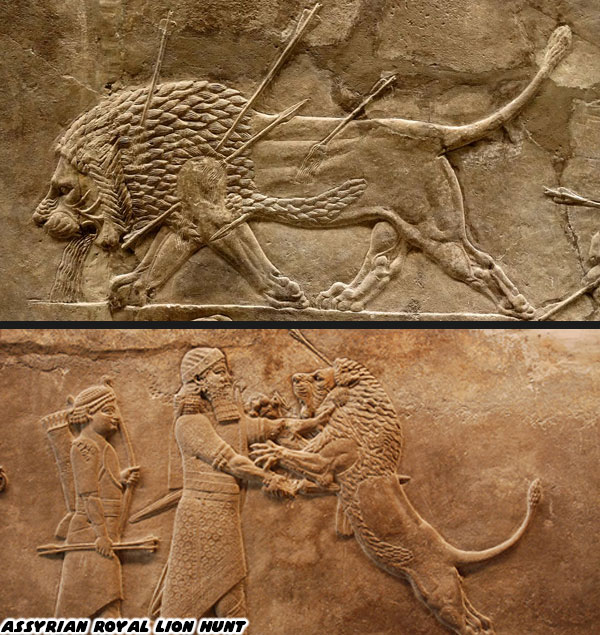
In ancient times the people of the Middle East were at the mercy of the Asiatic Lion. They were not as big as their African counterparts, but they were nonetheless dangerous. Leaders, and kings of the region would prove their bravery by hunting the lions. Many of these encounters were recorded on stone reliefs such as the
Assyrian royal lion hunt, circa 660 B.C.. The visual representation of animals covered in spears, and arrows made them seem even more monstrous, and unforgettable. We had seen it repeated with cave paintings of wooly mammoths, Native American paintings of buffalo hunts, and Chinese paintings of tiger attacks. Thousands of years later this tradition still exited. We would see it with Moby Dick covered in harpoons, and scars, but more recently with the design of Seto, the wolf-lion father of Red in Final Fantasy VII. Sometimes the hunts against these animals were exaggerated to make the kings seem bigger, stronger, or braver than they actually were. This is where they created mythology.
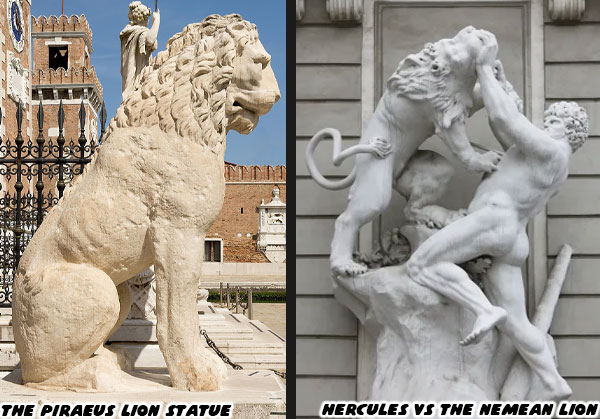
Ready at Dawn Studios was writing a new chapter in the story of Kratos. He had killed the gorgons Medusa, and Euyryale. He had killed the Hydra, Basilisk, and Scylla. Now he had defeated the Piraeus Lion. These encounters were the equivalent to the labors of Hercules. If you remember
Hercules’ first labor was defeating the Nemean Lion. The golden mane of the lion was impervious to man-made weapons, and its claws were sharper than swords. The only way that Hercules could defeat it was by strangling it. This battle was celebrated in paintings, on pottery, and in statue form. The lesser known fact was that there was also a statue of the Piraeus Lion. The massive sculpture was a landmark welcoming travelers several millennia ago. It was originally located in Athens, before it was stolen, and moved to Venice. Kratos succeeded with his god forged weapons where the man made ones had failed. He was every bit as amazing as the gods, and demi-gods that inspired the franchise. But I digress.
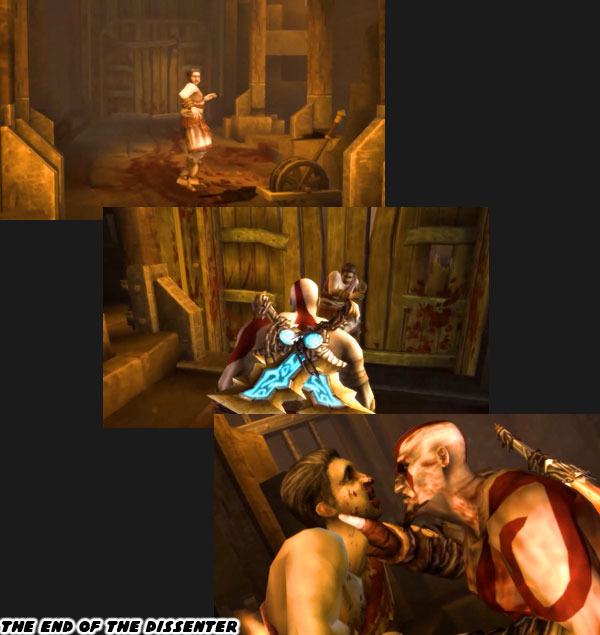
The entire time you are fighting the Piraeus Lion you can hear the Dissenter laughing, and taunting you from the other side of the cells. He says “Lord Ares is the true god of war” and “down with the impostor!” Of course he freaks out once Kratos kills the beast. He lets go of the lever, and tries running away. Unfortunately for him the other block doors won’t open. The game play slows down once more as it was on the streets of Sparta. We hear Kratos breathing heavy, and growling under his breath. He is now the monster stalking his prey. He grabs the Dissenter by the head, and throws him through the door. The Dissenter limps away, begging for his life. The other prisoners are taunting him, and looking for justice. Kratos shoves him through another door, and the Dissenter is now slumped over, coughing up blood. As Kratos picks him up by the throat, and buries the Blades of Athena in his torso his dying words are “Glory be to Sparta.” It brings a certain level of satisfaction to the player, but in a way the Dissenter wins because he never declares Kratos the new god of war. The next parts of the game were every bit as good as what came before. We are going to continue on the journey in the next blog. If you played through the Ghost of Sparta what did you think of of the Piraeus Lion fight? Let me know in the comments section please. As always if you would like to sponsor me
please visit my Patreon page and consider donating each month, even as little as $1 would help make better blogs and even podcasts!
































No comments:
Post a Comment